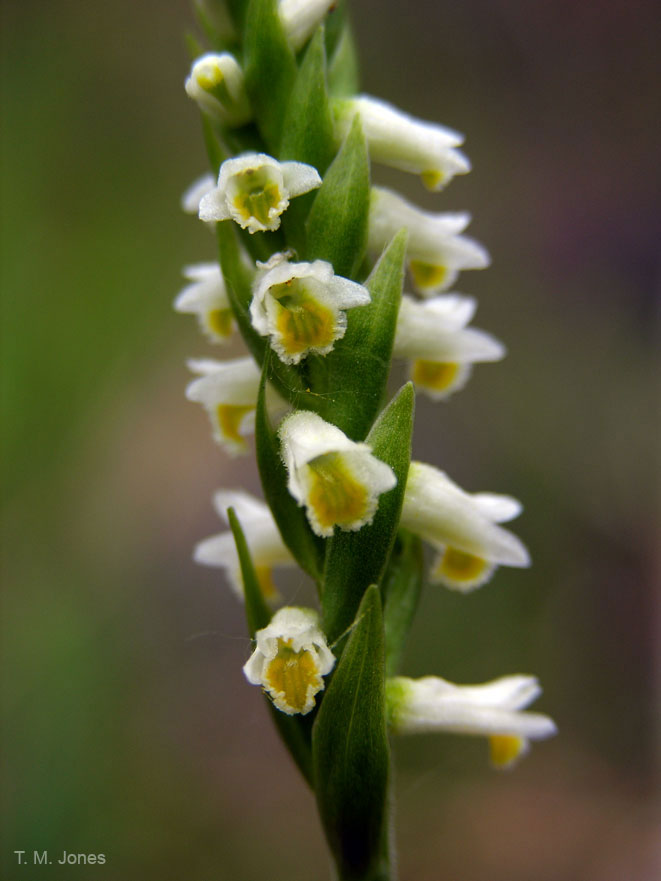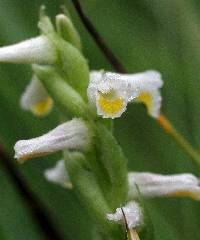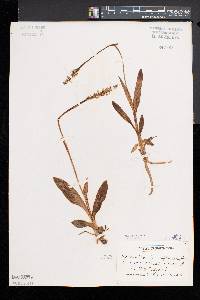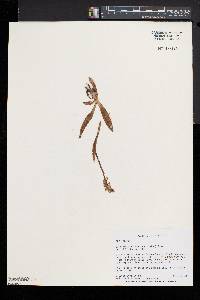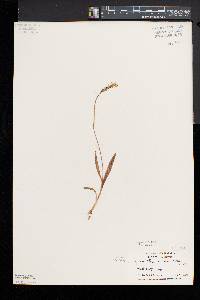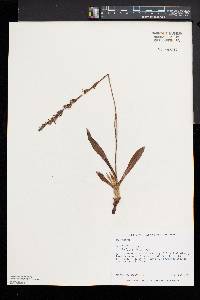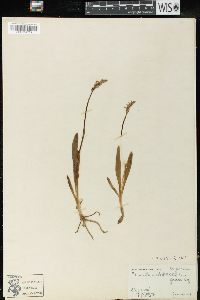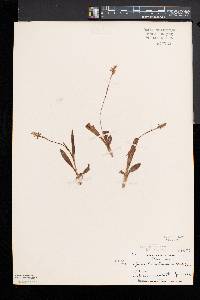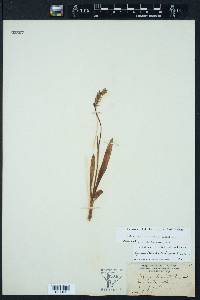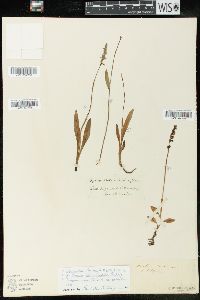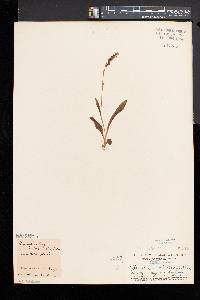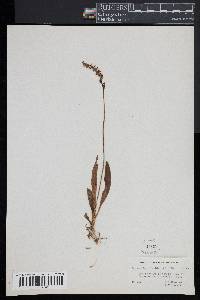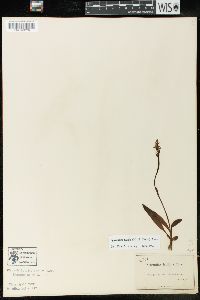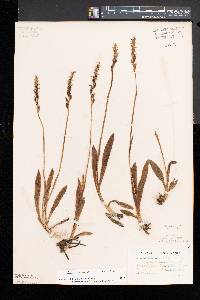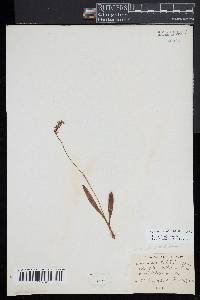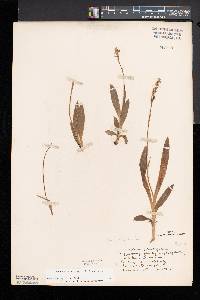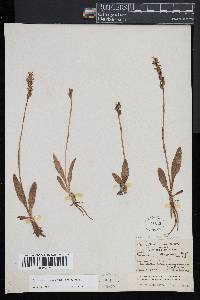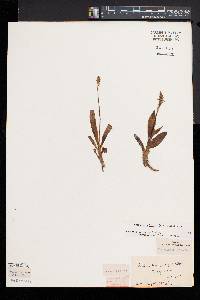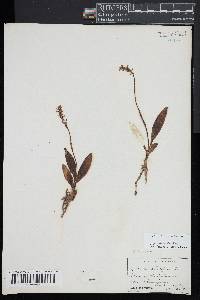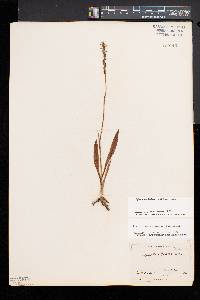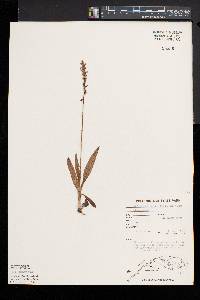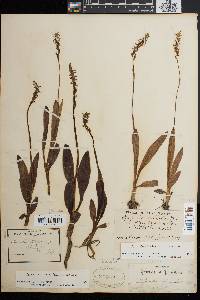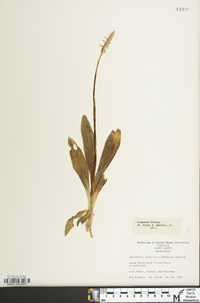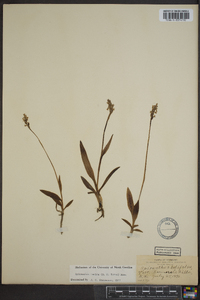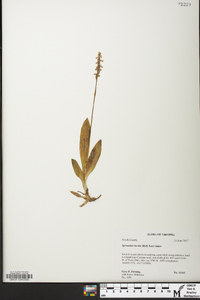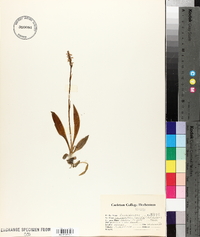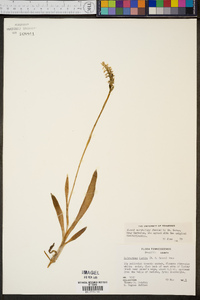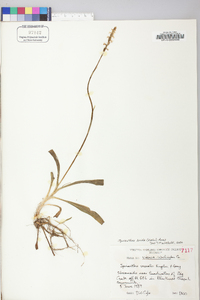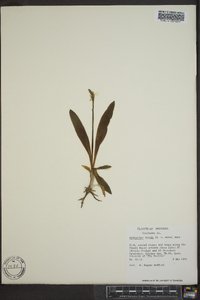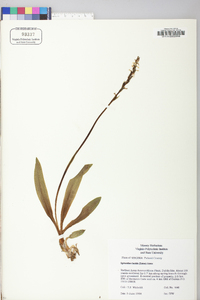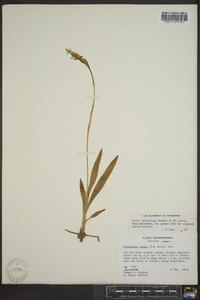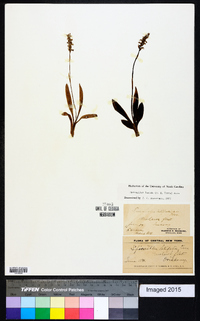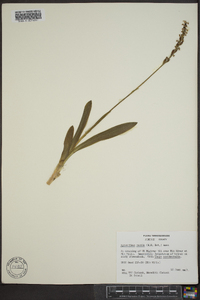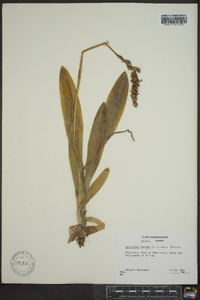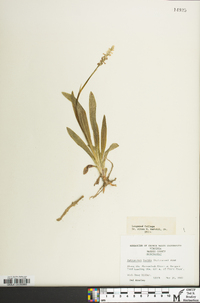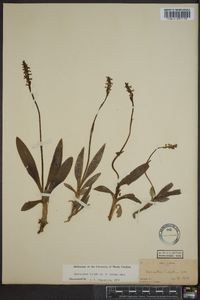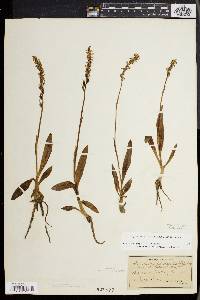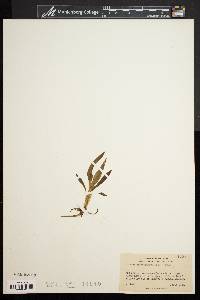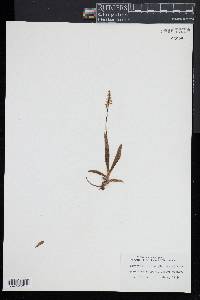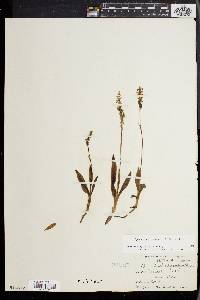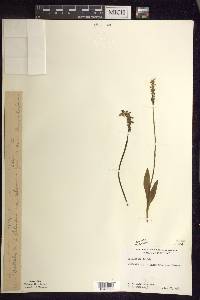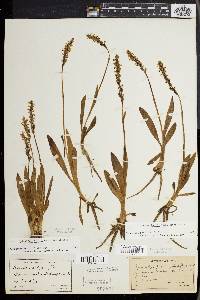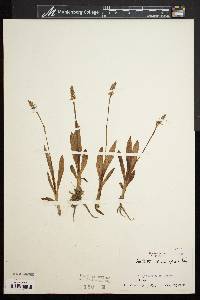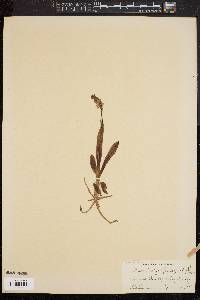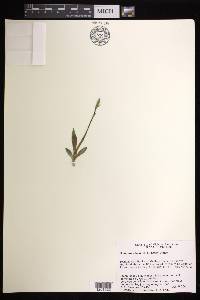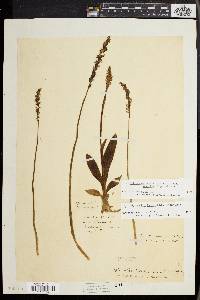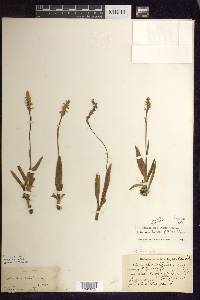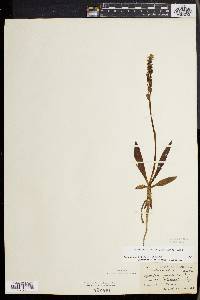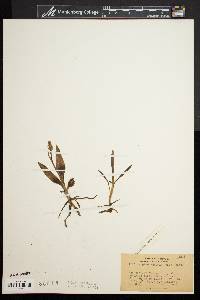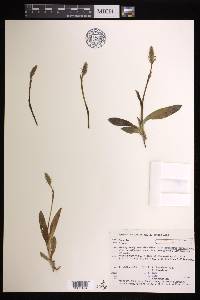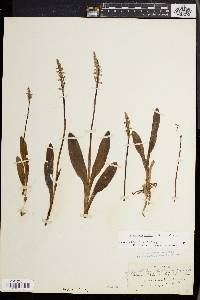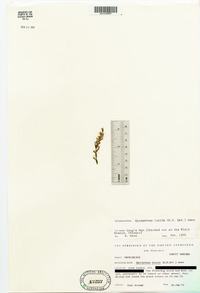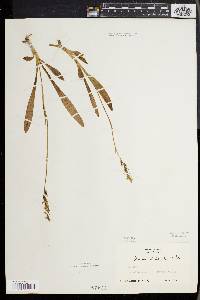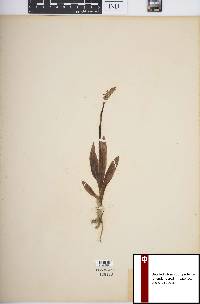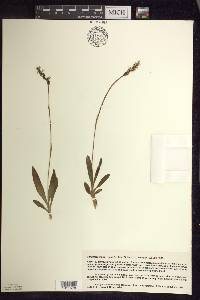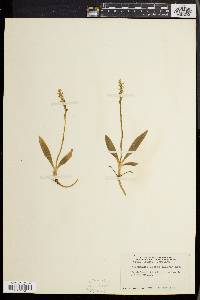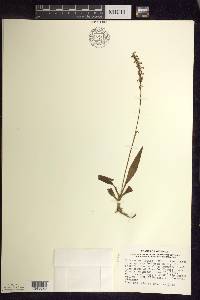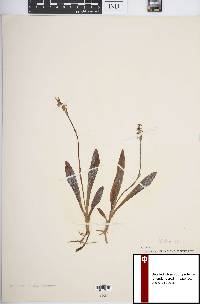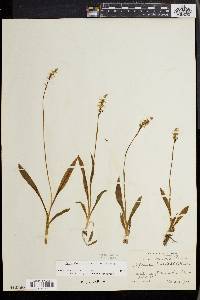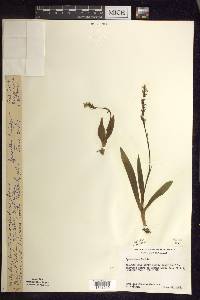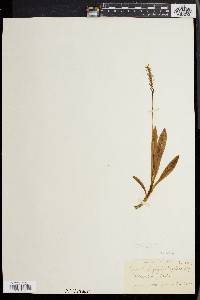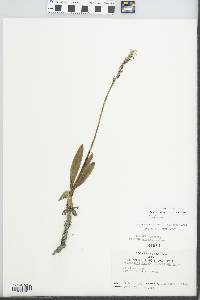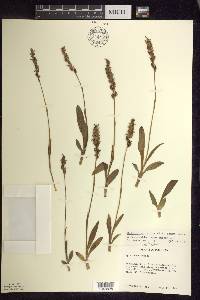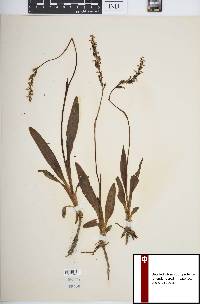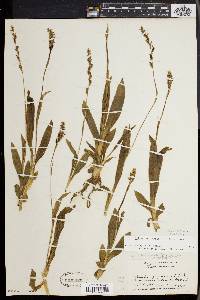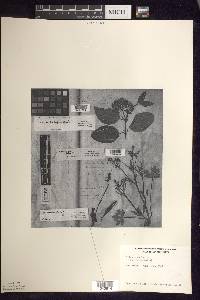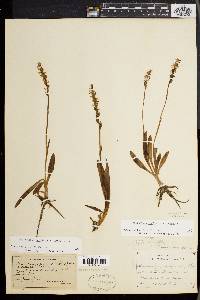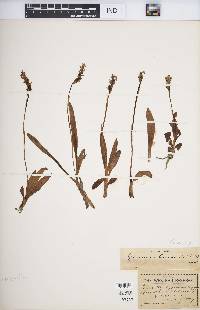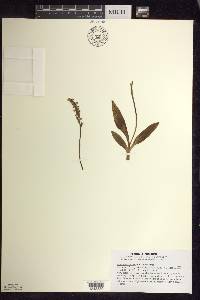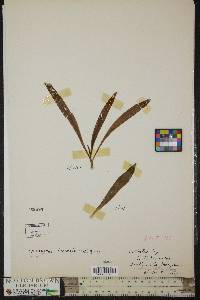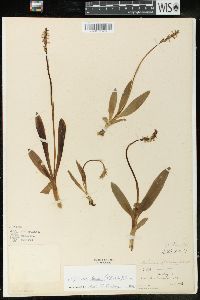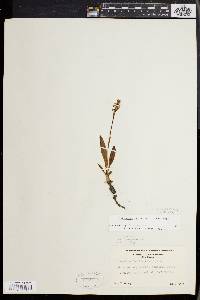Spiranthes lucida
|
|
|
|
Family: Orchidaceae
Shining Ladies'-Tresses, more...shining lady's tresses
[Neottia lucida H.H.Eaton] |
Plants 4-37 cm. Roots spreading to descending, slender, mostly to 0.6 cm diam. Leaves persisting through and long after anthesis, 3-4, basal, ascending-spreading, elliptic-lanceolate, 3-12 × 0.5-1.5 cm. Spikes rather openly spiraled, 3-4 flowers per cycle of spiral; rachis sparsely to moderately pubescent, some trichomes capitate, glands obviously stalked. Flowers nearly horizontal to abruptly nodding from base, white, tubular; sepals linear-oblong; dorsal sepal connate at base, 4.5-5.5 mm; lateral sepals appressed to petals and lip, straight, 5-6 mm × 1-2 mm; petals linear-oblong, 5-6 × 2-4 mm, apex obtuse; lip brilliant yellow or yellow-orange, centrally greenish yellow, oblong, 5-6 × 2-4 mm, margins crenulate, veins several, greenish, branches few, very short, mostly widely diverging, sometimes forming reticulum with primary veins; basal calli spreading, 1 mm; viscidium oval; ovary 3-8 mm. Seeds monoembryonic. 2n = 44. Flowering May--Aug. Rocky and sandy riverbanks, calcareous seeps, fens, 0--900 m; N.B., N.S., Ont., Que.; Conn., Del., Ill., Ind., Kans., Ky., Maine, Mass., Mich., Mo., Nebr., N.H., N.J., N.Y., Ohio, Pa., R.I., Vt., Va., W.Va., Wis. Perennial herb 4 - 37 cm tall Stem: single, erect, green, sparsely to moderately hairy, usually only with leaf-like sheaths most of length. Leaves: three to four, basal, ascending to spreading, shiny, hairless, non-toothed, 3 - 12 cm long, 0.5 - 1.5 cm wide, elliptic to lance-shaped. The leaves persist through flowering time and long afterwards. Inflorescence: a single, erect, terminal, elongate, rather open spike of fifteen to twenty horizontal to abruptly nodding flowers. The flowers are arranged in a loose spiral with three to four flowers per full turn around the axis. Axis sparsely to moderately covered with stalked glandular hairs and some round-tipped hairs. Flowers: white with yellowish lip, horizontal to nodding at base, bilaterally symmetric, 5 - 6 mm long, tubular without spur. The reproductive parts of stamens, stigma and style are fused into a column above the 3 - 8 mm long inferior ovary. Sepals: three (though slightly fused at base), petal-like, white, straight, forward-pointing and closely appressed to petals. The central, uppermost sepal is slightly shorter (4.5 - 5.5 mm long) than the two side (lateral) sepals, which are 5 - 6 mm long and 1 - 2 mm wide. Roots: spreading to descending, slender, up to 0.6 cm diameter. Lateral petals: two, forward-pointing, closely positioned with central sepal above lip, white, 0.5 - 1 cm long, lance-shaped with blunt-angled tips. Lip petal: one, central, lowermost, forward-pointing with slight downward curve, white with brilliant yellow or yellow-orange center, hairless, wavy-edged, 5 - 6 mm long, 2 - 4 mm wide, oblong with rounded tip. The surface of the lip has several greenish veins with a few, very short, divergent branches (sometimes forming a netlike pattern), and also two, small (1 mm tall), spreading projections (calli) at the base of the lip. Similar species: Spiranthes lucida is probably most similar in flower appearance to S. tuberosa, but that species flowers later in the season (after mid-July), its leaves are absent at flowering time, it is hairless throughout, and the lip is entirely pale or white. Also somewhat similar in terms of flower shape is S. cernua, but its lip petal differs by only having a narrow green area in the center, the veins branch in parallel patterns, and the lip shape differs by having a narrowed area at the middle. A species that shares the colored central area of the lip petal is S. lacera, but that coloring is more green never yellow, the leaves barely last until flowering time (often withered), and the lateral sepals are more spreading. A more northern species, S. casei has similar tubular-shaped flowers, but its lip petal is only a single color, and the outside of the flowers are covered (at least near base) with reddish, glandular hairs. Flowering: June Habitat and ecology: Rare, marly fens and wet calcareous prairies. Occurence in the Chicago region: native Notes: This is a more eastern species and barely reaches west into the Chicago Region. It is one of the earliest blooming of our Spiranthes, and the only species in the region that retains its leaves well past flowering time (Case 1987). It is also quite small and overlooked even in areas where it is more common. Etymology: Spiranthes comes from the Greek words spir meaning coiled, and anthes meaning flowers, thus referring to the spiral arrangement of the flowers in the inflorescence. Lucida means bright, clear, lustrous. Author: The Field Museum Slender, 1-2.5 dm; basal lvs lance-oblong, to 12 cm, 7-15 mm wide; cauline sheaths 2(3), much reduced, the upper scale-like; spike 2-7 cm, dense (especially above), the fls in ca 3 vertical ranks; axis of the spike minutely glandular-hairy; fls widely spreading; sep 5-5.5 mm, basally connate for 0.6-0.8 mm, directed forward (as also the lateral pet), somewhat spreading only near the tip; lip 5-6 mm, broadly oblong, rounded-truncate and erose distally, the distal two-thirds bright yellow or orange-yellow with white margins; basal callosities of the lip inconspicuous, under 1 mm; viscidium oval, 0.3-0.6 mm; seed-coat netted; 2n=44. Damp woods, marshes, and wet shores, calciphile; N.S. and N.B. to s. Ont. and Mich., s. to Ky. and w. Va. May-July. (S. plantaginea, a preoccupied name) Gleason, Henry A. & Cronquist, Arthur J. 1991. Manual of vascular plants of northeastern United States and adjacent Canada. lxxv + 910 pp. ©The New York Botanical Garden. All rights reserved. Used by permission. From Flora of Indiana (1940) by Charles C. Deam This species is local in the lake area where it is sparingly found on the springy, marl borders of lakes and in bogs elsewhere. In Jennings County in southern Indiana I found it at the base of a 75-foot cliff along the Muscatatuck River growing on narrow ledges of limestone in soil kept continually wet by seepage. In addition to the counties shown on the map it has been reported from Tippecanoe County. …… Indiana Coefficient of Conservatism: C = 10 Wetland Indicator Status: FACW |

